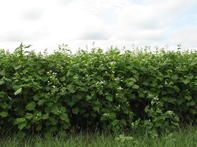Buckwheat (Fagopyrum esculentum), or (Fagopyrum esculentum Moench) is an annual flowering plant that grows up to 1.2m high with a shallow taproot and a short growing season. It is cultivated for its tiny triangular seeds for human consumption, as animal feed, and as a cover crop.

It is a ‘speciality grain’ not related to wheat. Yet, even though it is not from the grass family like cereals, it is classified among the cereal grains.
It is native to Southeast Asia and has been grown there for millennia. It was grown in China around 1000 A.D., introduced in Europe in the 15th century and then spread to the U.S. in the 17th century.
Producers of Buckwheat
Russia and China are the largest producers of buckwheat in the world with over 700 000 and 661 000 hectares, respectively. Other producers include Ukraine (167 000 ha), France (111 000 ha) and the USA (83 000 ha).
The use of buckwheat in South Africa is limited - it is mainly used as a cover crop. Buckwheat was widely planted a few decades ago in South Africa, but due to its poor harvest residues and wider dependence on crop residues for animal feeding, the production of buckwheat for its seeds is minor.
Uses of Buckwheat
Buckwheat is gluten-free, high in protein, fibre, magnesium, calcium, potassium, phosphorus, fatty acids: omega 3 and 6, niacin, and folate.
Buckwheat seeds, but especially the leaves, contain rutin a plant pigment, known to strengthen capillary walls. Green buckwheat tea has a high level of rutin and is therefore beneficial to limit cardiovascular disease, reducing the risk of the hardening of the arteries and also for its anti-oxidative effect.
The grain is eaten whole or dehulled, cooked into porridge, ground into flour or used as groats. The dehulled seeds, also known as buckwheat groats, are popular (raw or sprouted) in raw diets and is used in salads, added to soups and stews and used in crackers and granola.
Buckwheat flour (made from the ground seeds) are used to make noodles and incorporated into gluten-free baking mixes. Toasted buckwheat seeds are called kasha. The reddish-brown kasha has a strong nutty, toasted flavour. A traditional flour in Russia, Poland and other East-European countries, buckwheat is also used to make vinegar, beer, liquor and tea.
Buckwheat husks (after seeds are removed) can be fed to ruminants (cattle, sheep, goats, etc.) and poultry.
Due to buckwheat flowers’ popularity with bees, honey could be a byproduct to buckwheat farmers. Buckwheat honey is high in protein and contains 22 of the 24 of essential trace elements of which iron is in abundance.
By Marinda Louw